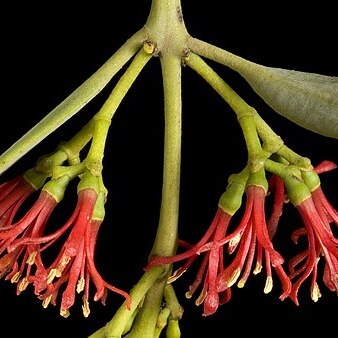Glabrous except for the ovary and young vegetative parts very rarely sparsely tomentose. Leaves opposite; lamina lanceolate to elliptic or obovate-spathulate, 2.5-10 by 0.5-3 cm, attenuate or cuneate at the base to a petiole 2-10 mm long, acute to rounded at the apex, dull on both sides; venation curvinerved, distinct on both sides. Inflorescences at the nodes, pedunculate 2-or 3-rayed umbels of triads with the central flowers sessile; peduncle 6-30 mm long; rays 3-10 mm long; pedicels of the lateral flowers 1.5-7 mm long. Corolla in mature bud 4-or 5-merous, 8-25 mm long, slender, clavate and obtuse at the apex, ridged or winged in the upper part, red, mostly very dark below and paler above. Anther 1-2 mm long, about one quarter as long as the free part of the filament.
A shrub which grows in the branches of other plants. It partly lives off these plants. The stems are smooth. The leaves are 2.5-10 cm long by 1-2.5 cm wide. Their shape varies. The flowering stalk is in the axils of leaves. The stalk can be 30 cm long. The flowers are in groups of 3. There are 2-3 of these groups in a cluster. They are bright red.

